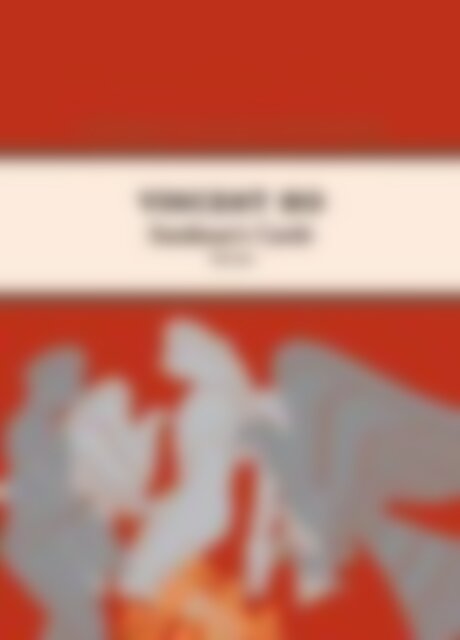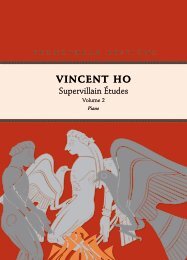Sandman's Castle (Preview)
by Vincent Ho | for Tam-tam
by Vincent Ho | for Tam-tam
- No tags were found...
Create successful ePaper yourself
Turn your PDF publications into a flip-book with our unique Google optimized e-Paper software.
PROMETHEAN EDITIONS<br />
VINCENT HO<br />
Sandman’s <strong>Castle</strong><br />
Tam-tam
Vincent Ho<br />
Sandman’s <strong>Castle</strong><br />
Tam-tam<br />
PROMETHEAN EDITIONS<br />
WELLINGTON
Sandman’s <strong>Castle</strong> (PE170), for Tam-tam by Vincent Ho (2014).<br />
Dedicated to Evelyn Glennie.<br />
© Promethean Editions Limited 2014<br />
First edition © 2020 Promethean Editions Limited<br />
Series Editor: Ross Hendy<br />
Editor: Ben Woods<br />
ISBN: 978-1-877564-70-3 (print)<br />
ISBN: 978-1-77660-170-7 (ebook)<br />
ISMN: 979-0-67452-306-6<br />
Promethean Editions Limited<br />
PO Box 10-143<br />
Wellington<br />
NEW ZEALAND<br />
http://www.prometheaneditions.com<br />
No part of this publication may be reproduced in any form or by<br />
any means without permission in writing from the Publisher.
Vincent Ho (1975)<br />
Born in Ontario, Canada, Vincent Ho began his musical training at Canada’s Royal<br />
Conservatory of Music in Toronto, where he received an Associate Diploma in Piano<br />
Performance in 1993. Mentored by a series of composers including Allan Bell, David Eagle,<br />
Christos Hatzis, Walter Buczynski, and Stephen Hartke, Ho gained degrees from the University<br />
of Calgary and the University of Toronto, and a Doctor of Musical Arts from the University<br />
of Southern California. While still an undergraduate student, Ho was awarded a scholarship<br />
to attend the Schola Cantorum Summer Composition Program in Paris, France, where he<br />
received tuition from faculty of the Juilliard School of Music and the Paris Conservatoire.<br />
Ho sprang to prominence in 1999, when he received prizes for his first string quartet and his<br />
piano work Three Scenes of Childhood, and an audience prize for the latter in the Toronto New<br />
Music Festival. String Quartet No.1 received further recognition nearly a decade later when<br />
it was nominated ‘Best Classical Composition of the Year’ in the Western Canadian Music<br />
Awards following its release on CD.<br />
Ongoing commissions have provided opportunities for Ho to produce many notable works<br />
for orchestra, including Nighthawks (2000), Dragon Realms (2006), Red Zen (2008) and<br />
Fallen Angel: In Memoriam Richard D’Amore (2008). Most significant is his Arctic Symphony<br />
(2010), a work inspired by a trip to the Arctic, which has been described as ‘a mature and<br />
atmospheric work that firmly establishes Ho among North American composers of note’<br />
(Winnipeg Free Press).<br />
Ho was Composer in Residence with the Winnipeg Symphony Orchestra from 2007 through<br />
2017, enabling him to complete three concertos in two years for renowned soloists such<br />
as Dame Evelyn Glennie and Shauna Rolston. Glennie commissioned and premiered The<br />
Shaman (2011) and From Darkness to Light: A Spiritual Journey (2013). City Suite (2012), for<br />
amplified solo cello and orchestra, was premiered by Rolston. In 2017 Centrediscs released the<br />
Juno Award-nominated album The Shaman & Arctic Symphony: Orchestral Music of Vincent Ho,<br />
PE170 – 3
consisting of the live recordings of The Shaman and Arctic Symphony featuring the Winnipeg<br />
Symphony Orchestra, Dame Evelyn Glennie, and the Nunavut Sivuniksavut Performers. The<br />
Shaman went on to receive a 2018 Juno Award nomination for Classical Composition of the<br />
Year, with Arctic Symphony landing Ho another Classical Composition of the Year nomination<br />
in 2019.<br />
In 2015 Canadian piano trio Gryphon Trio commissioned a new work from Ho. The resulting<br />
work, Gryphon Realms, was premiered in December of that year, with each movement based<br />
on the personalities of each player of the Gryphon Trio, along with gryphon mythology. Ho<br />
has recently explored elements of Chinese music and culture as part of his compositional<br />
development. In 2016 a co-commission from the Hong Kong Chinese Orchestra and the<br />
National Chinese Orchestra Taiwan resulted in Ho’s work for Chinese Orchestra, Journey<br />
of the Red Phoenix. The following year, the Toronto Symphony Orchestra commissioned<br />
and gave the premiere performance of Ho’s Rejuvenation: A Taoist Journey for narrator,<br />
solo pipa, and orchestra, featuring renowned Chinese pipa player Wu Man. In 2019, Ho was<br />
the recipient of the Society of Composers, Authors and Music Publisher of Canada’s Jan V.<br />
Matejcek New Classical Music Award.<br />
Ho’s music is rich and energetic—a unique integration of influences. His work often<br />
demonstrates the capacity to coherently synthesise and convey the felt inspiration incited<br />
by a multitude of artistic mediums. This amalgamation of influences is evidenced in Four<br />
Paintings by Leestemaker (2005), which musically construes the ‘murky,’ unsettling qualities<br />
communicated in the paintings of Leestemaker, and Arctic Symphony, where electroacoustic<br />
material is utilised in order to more effectively allow the listener to intuit the natural<br />
soundscapes from which the work emerged, as well as the sense of wonder experienced by<br />
the composer. Additionally, traditional classical music forms and the physical properties<br />
of the instruments and ensembles for which Ho writes are all inherent influences in his<br />
diverse and creative output. His music is sensual, sonorous and richly textured, and Ho gives<br />
considerable attention to the audience’s experience of his intricate sound-worlds.<br />
Latest information about the composer may be found at www.vinceho.com.<br />
PE170 – 4
Sandman’s <strong>Castle</strong> (2014)<br />
Sandman’s <strong>Castle</strong> sees Ho draw a multitude of sounds from a single tam-tam, most notably<br />
by having the player use an array of objects to strike or rub against the instrument. The dark<br />
timbre of the tam-tam disguises the playfulness at the heart of this enjoyable work, as the<br />
entire surface of the tam-tam is explored in an intriguing seven-minute journey. Ho allows<br />
time for the rich resonance of the tam-tam to be savoured in Sandman’s <strong>Castle</strong>, through his<br />
often spacious and gestural writing. Elsewhere, animal-like scratchings intensify to produce<br />
dense rolls that display the deep power of the instrument.<br />
The composer writes:<br />
Sandman’s <strong>Castle</strong> was written for Dame Evelyn Glennie as part of the “50 for 50” project<br />
to celebrate her 50th birthday. Fifty composers wrote 50 measures of music for a solo<br />
percussion instrument. For this project, the tam-tam was my instrument of choice. For<br />
years I had been quite drawn to its sonic beauty and its many expressive possibilities.<br />
In addition to this, writing for such an instrument would allow me to explore uncharted<br />
territories and open up new directions in my creative thinking.<br />
To ensure that the work would be tailored to Ms. Glennie’s talents—something I always<br />
think about when composing for a performer of her caliber—I asked her to film herself<br />
improvising on the tam-tam, using as many different mallets, sticks, and other items,<br />
as she could think of. This helped to open my eyes and ears to the variety of sounds<br />
she was able to draw out of the tam-tam. Watching her interact with the tam-tam was<br />
truly mesmerizing, like witnessing a shaman drawing up otherworldly sounds from<br />
a primordial realm. I was inspired by the many techniques Ms. Glennie used in her<br />
improvisation, as well as the sound colours she created. It did not take long for me to<br />
draft up a musical narrative based on her natural gestures and imaginative soundscapes.<br />
Personally, I view this work as a magical journey into the world of dreams, ruled by the<br />
mystic Sandman, with Ms. Glennie as our guide.<br />
PE170 – 5
Sandman’s <strong>Castle</strong> received its premiere performance from Dame Evelyn Glennie, at the<br />
Museum of Old and New Arts (MONA) Festival of Music and Art, in Hobart, Australia, on<br />
17 January 2016. This edition includes revisions, made by the composer after the premiere,<br />
which shortened the work to less than 50 measures.<br />
Instrumentation<br />
• 1 large tam-tam<br />
• 2 metal knitting needles<br />
• 1 large superball mallet<br />
• 1 medium superball mallet (alternatively 3 medium or small superball mallets with their<br />
sticks tied together)<br />
• 1 small superball mallet<br />
• 2 triangle beaters<br />
• 1 shell wrist shaker<br />
• 2 Korean metal chopsticks<br />
• 2 snare drum sticks<br />
• 1 tam-tam beater<br />
• 1 or more music boxes. Pull-string versions are the most convenient so that they<br />
automatically stop. The music boxes can all be the same music or entirely different from<br />
one another. Choose themes that are simple and suitable for young children (e.g. Brahms’<br />
Lullaby, Happy Birthday, J.S. Bach’s May the Sheep Safely Graze, etc.; definitely no pop<br />
songs).<br />
• Thimble (optional)<br />
PE170 – 6
Performance notes<br />
Refer to the diagrams below for the areas of the tam-tam to be played as detailed in the score.<br />
Both hands may be used unless specified otherwise.<br />
When two voices or staves are present the upper is the right-hand and the lower is the lefthand.<br />
When only one voice is present the right-hand positioning notation is used.<br />
R.H.<br />
㠜<br />
㠜<br />
㠜<br />
㠜<br />
L.H.<br />
œ<br />
œ<br />
œ<br />
œ<br />
outer edge<br />
[12:00]<br />
㠜 [3:00]<br />
œ<br />
æ æ<br />
Ͼ<br />
ã œæ<br />
æ œ<br />
æ<br />
Diverging lines = hands<br />
moving in contrary motion<br />
ã<br />
ã<br />
∑<br />
∑<br />
[12:00]<br />
㠜 [3:00]<br />
œ<br />
æ æ<br />
[12:00] Ͼ<br />
ã œæ<br />
æ œ<br />
æ<br />
ã<br />
Playing position<br />
as a clock face<br />
∑<br />
[9:00]<br />
ã<br />
∑<br />
[3:00]<br />
[6:00]<br />
PE170 – 7
Sandman’s SANDMAN’S <strong>Castle</strong> CASTLE TO EVELYN GLENNIE<br />
Vincent Ho <br />
ã<br />
Knitting Needles<br />
scrape<br />
surface<br />
R.H.<br />
œa > œ œa ><br />
œ<br />
œ œ œa ><br />
œ<br />
J<br />
f f ß ƒ<br />
⇤<br />
ß<br />
2<br />
ã<br />
œ> œ œ œ œ> .<br />
J<br />
œ œ > ˙a œ<br />
œ<br />
ƒ f ƒ p ƒ<br />
œ œ œ .<br />
œ<br />
J<br />
rit.<br />
œa œa<br />
œa<br />
F p F<br />
scrape edge, like<br />
a quick breath<br />
œa<br />
J<br />
4<br />
ã<br />
Finger Tapping<br />
(retain needles with thumb)<br />
œa > ><br />
⌅ ⌅ ⌅ ⌅ œ . ⌅ ⌅ ⌅ œa ><br />
œ<br />
J<br />
P P F p<br />
Knitting Needles<br />
Π= 120<br />
rit.<br />
5<br />
œ><br />
œ œ œ œ œ œ . œ œ .<br />
ã<br />
3<br />
ƒ<br />
œ<br />
J<br />
œa<br />
p<br />
(put down<br />
needles)<br />
Hands<br />
œa<br />
knock<br />
P<br />
scratch surface<br />
with fingernails<br />
œ<br />
J<br />
ß<br />
fist or palm<br />
(warm sound)<br />
œa<br />
?<br />
F<br />
7<br />
ã<br />
Π= c.60<br />
accel.<br />
Œ Œ Œ<br />
Medium Superball<br />
˙ .<br />
⇤<br />
like wailing sounds<br />
⌅ Œ<br />
Œ<br />
˙ .<br />
⌅<br />
œ œ œ œ œ<br />
Π= 108<br />
œa Œ Œ<br />
ß<br />
˙ .<br />
ã<br />
⇤<br />
Large Superball<br />
⌅ Œ<br />
Œ<br />
˙ .<br />
⌅ Œ<br />
Œ<br />
œ œ œ œ œ œ<br />
œa Œ<br />
ß<br />
Œ<br />
10<br />
ã<br />
ã<br />
Π= 60<br />
w<br />
⇥<br />
∑<br />
ad lib.<br />
like a murmur<br />
or distant drone<br />
œ<br />
,<br />
œ œ<br />
tap outer edge with superball stick<br />
œ œa<br />
⇤ f p F p f<br />
p f p<br />
p - P<br />
f<br />
Sandman’s <strong>Castle</strong> © 2014 2015 Promethean Vincent Ho Editions Limited<br />
This edition © 2020 Promethean Editions Limited<br />
PE170 – 8<br />
ISMN: 979-0-67452-xxx-x<br />
979-0-67452-306-6
12<br />
ã<br />
ã<br />
scrape outer edge<br />
with superball stick<br />
œ<br />
J<br />
ß<br />
‰}<br />
p - P<br />
Free improvisation<br />
but reserve climactic moments for later<br />
œ<br />
ß<br />
put down superball<br />
13<br />
ã<br />
ã<br />
Œ Œ œ<br />
p<br />
œ<br />
Œ<br />
ƒ<br />
Hands<br />
finger tapping<br />
put down superball<br />
œ<br />
æ<br />
ƒ<br />
knocking<br />
œ<br />
æ<br />
P<br />
finger tapping<br />
˙æ .<br />
æ<br />
p sub.<br />
scratching (frenetic)<br />
[3:00] [12:00]<br />
wæ<br />
w<br />
æ<br />
[9:00]<br />
ƒ<br />
j<br />
œ@ ‰ Œ<br />
˙æ<br />
p<br />
[12:00]<br />
16<br />
ã<br />
ã<br />
Œ<br />
j<br />
œ<br />
ß<br />
‰<br />
Triangle Beater<br />
œ<br />
glide on surface<br />
π<br />
scratch surface<br />
like a quick breath<br />
p - P<br />
move in circular motion<br />
Triangle Beater<br />
œ<br />
π<br />
p - P<br />
Improvisation<br />
but only gliding triangle beaters on the surface exploring<br />
as many sounds, dynamics, and expressive possibilities.<br />
18<br />
ã<br />
ã<br />
tap on surface<br />
P<br />
J<br />
><br />
œ<br />
f<br />
3<br />
œa<br />
œ<br />
J<br />
ß<br />
‰<br />
Strike and rub surface;<br />
like scrubbing.<br />
19<br />
> .<br />
ã<br />
Shell Wrist Shaker<br />
˙<br />
æ<br />
ß<br />
p<br />
Œ}<br />
tap edge with shells<br />
œ > .<br />
˙><br />
.<br />
œ><br />
⇥ ⇥ ⇥ ⇥ ⇥ ⇥ ⇥ ⇥ ⇥ ⇥<br />
æ<br />
æ<br />
œ<br />
æ<br />
ƒ<br />
P ƒ<br />
p f p<br />
PE170 – 9
21<br />
ã<br />
ã<br />
Swipe surface with shells, then shake shells<br />
in the air while slowly putting it down.<br />
œ<br />
J<br />
ß<br />
Metal Chopstick<br />
œ œ œ œ œ œ œ œ œ œ œ<br />
f<br />
Π= 108<br />
Metal Chopsticks<br />
œ œ œ œa > ? Œ<br />
œ œ œ œ > œ><br />
.<br />
3<br />
ß f ƒ<br />
23<br />
œa<br />
ã<br />
> ,<br />
,<br />
, like little critters or insects. ><br />
œ œ œ œ œ œ œ œ œ œ<br />
ß<br />
Irregular tremolo;<br />
like fast Morse code.<br />
π - p<br />
Move around the surface;<br />
ƒ<br />
ƒ<br />
ã œ} œ > 3 œ œ œ œ > 3 ><br />
a œ œ œ œ œ j<br />
ß<br />
><br />
œa ><br />
j<br />
(interruption)<br />
ß<br />
œa<br />
œ œ}<br />
Irregular rubbing on the outer<br />
edge, use side of chopstick; like<br />
nervous shaking or shivering.<br />
smoothing out<br />
accel. Π= 120+<br />
25<br />
œ œ œ œ œ œ œ œ œ<br />
ã<br />
œb<br />
J<br />
F<br />
L.H. take Drum Stick<br />
f<br />
26<br />
j<br />
ã<br />
Π= 104<br />
œ ><br />
‰ œa ‰ œ a œ œ<br />
J œ œ<br />
ß<br />
Drum Sticks<br />
ƒ<br />
L.H.<br />
P<br />
27<br />
.<br />
ã<br />
˙<br />
æ<br />
f<br />
œ<br />
œ<br />
œ<br />
œ<br />
P<br />
f<br />
29<br />
ã<br />
Œ = 112–148<br />
> > > ><br />
p sub.<br />
4×–6×<br />
Explore full surface area; become more<br />
ornamented with each repeat.<br />
œ<br />
R<br />
f<br />
œ œ œ œ œ œ œa.<br />
Œ}<br />
3<br />
31<br />
ã<br />
6×–8×<br />
> > > > sim.<br />
> > > > ><br />
P<br />
ƒ<br />
œ œ œ œ œ œ œ œ œ œa.<br />
Œ}<br />
PE170 PE170 – 10 10
ƒ<br />
ß<br />
> 3<br />
33<br />
> > > > > œa œ œ œ œ > œa<br />
ã<br />
P<br />
><br />
ã œ > œ > œ > œ > œ > œ > œ > œ > œ > œ > œ > œ > œ > œ > œ<br />
34<br />
œ> œ œ > œ œ > œ œ œ > œ œ<br />
ã<br />
ƒ<br />
Free improvisation<br />
5–10”<br />
36 3<br />
œ> > œ > œ<br />
><br />
ã<br />
. . . .<br />
œ . . . .<br />
3<br />
ƒ<br />
> 3<br />
rit.<br />
> œa<br />
œb<br />
><br />
Ï<br />
Tam-tam Beater<br />
œa<br />
ƒ<br />
40 Music Boxes<br />
ã<br />
If using more than one, start each music box one at a time separated<br />
by a phrase (approximately); like subject entrances of a fugue.<br />
41<br />
ã<br />
ã<br />
Improvisation<br />
– Distant wailing sounds and ad lib.; play as an eerie counterpoint to the music boxes<br />
– With the other hand, incorporate other various techniques (e.g. tapping, flicking, knocking, etc). You may use thimbles.<br />
– Optional: You may also incorporate vocal sounds (e.g. whistling, whispering, hissing, clucking, singing, etc).<br />
Small Superball<br />
ã<br />
ã<br />
– Fade out as music boxes begin slowing down to a stop.<br />
– Die away before the last music box stops.<br />
} Π?<br />
} Π?<br />
– If music boxes are not pull-string driven, slowly close or stop each one.<br />
– Wait a little longer after each one before stopping the following ones (e.g. wait 5 seconds<br />
after stopping the first one before stopping the second one, then wait 6–7 seconds before<br />
stopping the next one, then wait 8–9 seconds, and so on).<br />
PE170 11<br />
PE170 – 11
PROMETHEAN EDITIONS


















